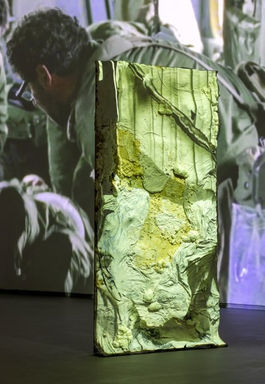
Israel Ministry of Foreign Affairs

「アモス・ギタイ“戦争レクイエム”」展 / アートが映しだすイスラエル社会
“紆余曲折”―。戦後50年企画だったはずのギタイとジョージ・シーガルの展示。いまや企画当初とは違う強度で、イスラエル社会の行方を芸術的・重層的に考察する機会となっている。
― ギル・マルコヴィッチ(イスラエル大使館文化・科学担当官)
2023年9月、テルアビブ 美術館にてアモス・ギタイ氏の写真展が公開された。キプール戦争の勃発から50年経ち、その戦争が人々に与えた影響をギタイ氏の目と気魄を通して紹介している。過去そして現在において、どのようにキプール戦争がイスラエル社会を象ったか見極めるのは骨の折れる仕事であり、不可能に近い――特にギタイ氏のカオスな戦争観と体験を通しては。奇襲や指導者の失態、数多の死者などのトラウマ的な出来事に耐えながら、それでもキプール戦争がイスラエル社会において、新たな意識層の形成に大きな役割を果たしたのは確かだ。キプール戦争とその影響は人々の心にも、また社会的にも、今もなお決着がついていない。この写真展は当時と現在、そしてその狭間に生きたギタイ氏の視点に焦点を当てている。この戦争をきっかけに、ギタイ氏は建築家から映画製作へとキャリアを転換させた。1973年10月6日の昼過ぎ、ヨム・キプールの静寂を切り裂くサイレンを聞いたギタイ氏は、スーパー8ビデオカメラを持ち、イスラエル陸軍特殊部隊に所属する友人と共に北部ゴラン高原に車を走らせ、戦争を目撃した。彼の自発的な記録は高い評価を受け、彼を映画製作というキャリアへと導いた。
キプール戦争勃発5カ月前の1973年5月、アメリカのポップ・アーティスト、ジョージ・シーガル氏の彫刻作品『イサクの燔祭』が、初めてテルアビブにあるマン公会堂の広場で公開された。シーガル氏は1960年代に等身大の白い石膏彫刻で知られるようになり、彼の多くの作品が公共の場に展示された。通常、石膏は型に使われる素材であり、最終的な彫刻作品には使用されない。そのため、彼の作品は時が経つにつれて損傷するため、物理的にも比喩的にもそのもろさを表現している。シーガル氏がイサクの燔祭の物語を題材に選んだのは、父親へのオマージュと聖書の物語への親近感からだった。聖書の話はこうだ。神がアブラハムに息子イサクを犠牲に捧げるよう命じる。アブラハムはその命令通り、イサクを祭壇に縛るが、神の使いに止められる。そこに雄羊が現れ、イサクに代わって屠られる。そして神はアブラハムの従順さを称賛する。しかし今回の戦争が 始まったことで、その物語が必然的に政治的、社会的な意味を帯びることになった。つまり、アブラハムの息子たち(イスラエルの民)は屠られているのに、代わりの雄羊は現れず、民は贖われず、死から救われなかったのである。縛られたイサクのイメージは戦争の嵐を表現するものとなり、戦場で子供たちを犠牲にする家族と重なっていった。 1977年、この彫刻はテルアビブ美術館内の、近代美術コレクションに寄贈された。今回『戦争レクイエム』展が企画された際、同美術館の主任学芸員だったオラ・ラピドット氏は、歴史上で自然に絡み合ったこの二つの作品の共演を決心した。そして現在、ギタイ氏が戦争中に撮影した映像が流れ、彼が帰国した年に制作した絵画のすぐ後ろの壁に、そのシーガル氏の彫刻(キュレーターはタル・ブロイトマン)が展示されている。
今、テルアビブの文化施設が果たす役目
写真展の公開から1カ月後、そして奇しくもキプール戦争から50年後の2023年10月7日、ハマスがイスラエル軍基地や非武装の市民を残忍にも攻撃した。イスラエル国民は再び、この国の過去のトラウマに立ち向かうことになった。ハマスの攻撃を引き金に「鉄の剣」作戦が開始され、それは今も継続中だ。イスラエルの異種な社会にはさまざまな見解があり、争議がある。しかし、ひとつ確かなことがある――ハマスは連れ去った子ども、高齢者、男性、女性といった拉致被害者を、イスラエルに帰さなければなければならないということだ。何よりもまず、彼らを取り戻さなければならないのだ。
戦争のためイスラエルの美術館が2カ月間閉鎖されたことにより、人々が黙想し、心の奥深くを省みることができる場所が使用できなくなってしまった。12月中旬には再開されている。テルアビブ美術館の広場は、現在のイスラエルの戦争に対して公に意見をし、拉致被害者の開放を訴える場となっている。
キプール戦争はギタイ氏の人生を決定づけ、回避的記憶などというインスピレーションを刺激する問いの答えを探求する出来事となった。彼の長編特作映画『キプール』(2000年)では、主人公が恋人と愛し合っているときに、警報が鳴り始める。白いベッドシーツが大きな染みに覆われ、愛し合うカップルもゆっくりとその染みに飲み込まれていく。主人公と同様に、観客は感情や思考、温かさや親密さを併せ持った現在と、戦場から兵士を避難させ、仲間の命を救おうとする未来の状況に、どんどん心がかき乱されていく。
今、イスラエル精神のフェノメノロジー(現象学)はどこに向かい、50年後の芸術にどのように反映されるのだろうか。ヨルダン川から地中海に住むすべての人のための平和の物語、戦争ではなく愛に染まった物語が語られる時が来ることを願うばかりである。
(訳・宮森久子)
<展示>
"Amos Gitai: Kippur, War Requiem(アモス・ギタイ『戦争レクイエム』)"
キュレーター: ミラ・ラピドットMira Lapidot
アシスタントキュレーター: Amit Shemma
会期: 2023年9月13日~2024年2月10日
会場:テルアビブ美術館
27 Shaul HaMelech Blvd., Tel Aviv-Yaffo
https://tamuseum.org.il/en/exhibition/amos-gitai-kippur-war-requiem/

ギル・マルコヴィッチ (駐日イスラエル大使館 文化・科学担当)
イスラエル・ヘルツリヤ学際研究所で法学と政治学を、テルアビブ大学 で哲学(修士)を学ぶ。 専門は、多様な学術知識を一般の人々がより利用しやすくするためのフォーマット開発。イスラエル公共放送の教育ラジオ番組「HaMa'abada」(「The Lab」)を制作、4 年間編集・司会を務めた。また同じような問題に関心をもちながらも異なるアプローチをするアーティストと学術研究者をペアリングし、多角的な視点よってテーマに対する理解を深めるプロジェクトを主宰した。オペラ歌手、コンテンポラリーダンサー、パフォーマンス、オリジナル・サウンドトラック制作など、アーティストとしても活動。2023年11月より現職。













